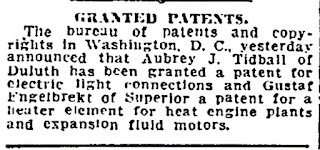Ordinary people usually get little if any mention in local history books and don't leave voluminous personal papers in archives, but they do find their way into local newspapers. Duluth was a large enough town to support more than one daily newspaper, but small enough for newspapers to serve as a sort of early 20th-century social media.
Over the past 50 years, many historical newspapers were saved on microfilm, but searching the microfilm for family history was a slow, tedious exercise. Now, both commercial (Newspapers.com, Genealogy Bank, and Newspaperarchives.com) and free services (ChroniclingAmerica.gov) make it easier than ever to search digitized historical newspapers. Of course, the searches are easier when the name is unusual. Tidball is a good example.
Here are some stories from the Duluth News-Tribune that give some flavor of the lives of the Tidball families in Duluth.
- HALLOWE'EN PARTY. The Christian Endeavor society of the First Christian church will entertain at a Hallowe'en party Friday evening in the church parlors. The social committee which is arranging the details consists of Miss Lottie Austen, Mrs. C. A. Palmer and Ambrey [sic] Tidball. (26 October 1910, p. 6)
- Mr. and Mrs. Aubrey Tidball, 2815 Minnesota avenue, entertained at a swimming and beach party Friday night in compliment to their house guest, Miss Barbara Teacore of Minneapolis... A swimming frolic was engaged in until 9 o'clock, when a marshmallow roast on the beach was enjoyed. (20 August 1916, p. 6)
- The Study of the Latin-American countries will occupy the year's work of the [Women's Missionary] society... 'The Extent and Location of the Countries in Latin America' will be the subject of a talk by Mrs. Aubrey Tidball... (18 October 1916, p. 7)
- Esley W. Tidball, corporal of the Home guard drum corps, has received an appointment to the officers' training school at Camp Zachary Taylor, Ky., instead of a commission as previously reported. (21 August 1918, p. 3)
- GRANTED PATENTS. The bureau of patents and copyrights in Washington, D.C., yesterday announced that Aubrey J. Tidball of Duluth has been granted a patent for electric light connections... (20 April 1919)
Thomas may have avoided drink, but he had a problem with lard. Under a headline reading "Sold Adulterated Lard," the 2 December 1902 issue of the News-Tribune reported:
Thomas Tidball, a grocer at 218 West Fourth Street, was tried in the municipal court yesterday for selling lard adulterated with beef tallow. He was fined $25 and costs. The complaint was made by Otto Giffert, agent for the food and dairy commission, and the offense was committed last June. Mr. Tidball ordered the lard from a wholesale house, and had no knowledge that it was adulterated.
Is this all the news that was fit to print? No, this is just a sampling. Historical newspapers are deep mines for family history. Start digging!




